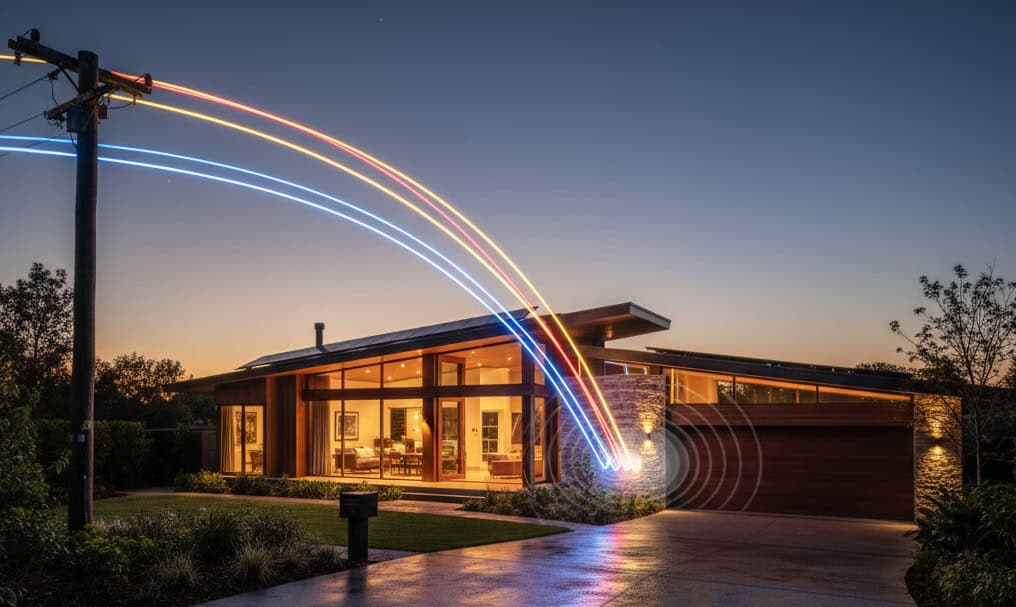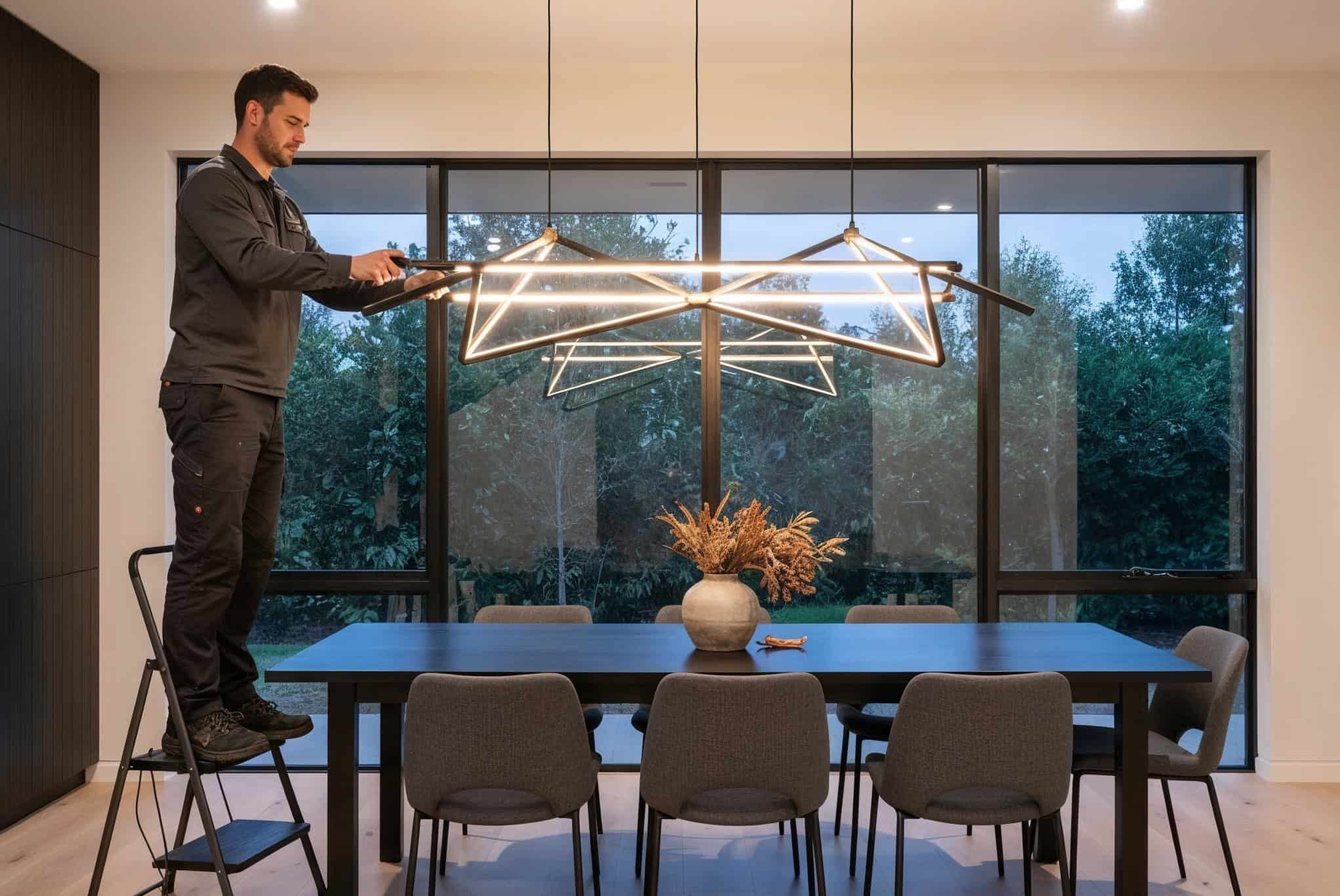Why did the ethernet cable break up with WiFi? Because it was tired of all the connection issues!
If your internet connection is slower than a Melbourne tram in peak hour traffic, it might be time to consider professional data cabling installation. In our increasingly connected world, reliable internet isn’t just a luxury—it’s as essential as a good cup of coffee on a Monday morning.
Welcome to your comprehensive guide to data cabling installation in Melbourne, brought to you by Luno Electrical. With over 160 five-star Google reviews and a registered master electrician who’s always on time and always cleans up afterwards, we’ve seen more tangled cable situations than a plate of spaghetti at an Italian restaurant. Whether you’re building a new home, upgrading your current setup, or just tired of yelling at your router, this guide will walk you through everything you need to know about network points, structured cabling, and why professional installation is worth every penny.
What is Data Cabling Installation?
Data cabling is like the nervous system of your home—it carries all the important signals, just hopefully with fewer headaches than your actual nervous system! At its core, data cabling installation involves running physical cables throughout your property to create a robust network infrastructure that supports internet, phone, and other telecommunications services.
Unlike the electrical wiring that powers your lights and appliances, data cabling carries digital information. Think of it as creating superhighways for your data to travel on, rather than forcing it to take the scenic route through potentially unreliable wireless connections.
There are several types of cables used in modern installations:
Cat5e Cable: The reliable workhorse that’s been around the block. Good for basic internet and phone services, but starting to show its age like a flip phone at a smartphone convention.
Cat6 Cable: The current gold standard for most residential installations. Faster speeds, better performance, and more future-proof than its Cat5e cousin.
Cat6a Cable: The overachiever of the cable family. Perfect for commercial applications or homes where you absolutely, positively need the fastest speeds possible.
Fiber Optic Cable: The speed demon that uses light to transmit data. So fast it makes regular copper cables look like they’re moving through treacle.
Here’s the important bit: in Australia, data cabling installation isn’t a DIY weekend project. Under the Telecommunications Act 1997, only registered cablers can perform permanent data cabling work. It’s not just a suggestion—it’s the law, and breaking it can result in hefty fines that’ll make your wallet cry harder than watching your internet bill increase.
When Do You Need Data Cabling Installation?
What do you call internet that works perfectly everywhere in your house? A myth!
Recognising when you need professional data cabling installation is usually easier than spotting a tourist in Federation Square. Here are the telltale signs:
Slow Internet Speeds: If your WiFi is slower than a snail carrying shopping bags uphill, it’s time for data cabling. When Netflix starts buffering more than a politician avoiding questions, you know something needs to change.
Dropped Connections: If your video calls drop out more often than a university student’s attendance, poor network infrastructure might be the culprit.
Dead Zones: Areas in your home where WiFi goes to die, usually coinciding with exactly where you want to work or relax.
New Home Construction: Building a new home without proper data cabling is like buying a car without wheels—technically possible, but not very practical.
NBN Preparation: With the NBN rollout across Melbourne, ensuring your home’s internal cabling can handle high-speed internet is crucial. There’s no point having a Ferrari connection if your internal roads are still dirt tracks.
Smart Home Integration: Planning to automate your home? Proper data cabling provides the reliable backbone needed for smart devices, security systems, and home automation that actually works consistently.
Multiple Heavy Internet Users: If your household has more devices than a tech reviewer’s office, hardwired connections can take the pressure off your wireless network.
The golden rule? If you’re experiencing any connectivity issues that make you want to throw your router out the window, it’s probably time to call in the professionals.
Types of Network Points & Structured Cabling
Think of structured cabling like this – everything has a place and brings you joy (and fast internet)! Understanding the different components helps you make informed decisions about your installation.
Data Points vs. Phone Points: While they might look similar, data points and phone points serve different purposes. Data points (or ethernet outlets) provide high-speed internet connections, while phone points handle traditional telephone services. Modern installations often combine both functions into versatile outlets.
Ethernet Wall Outlets: These are your access points to the wired network. Professional installation ensures they’re positioned strategically throughout your home—in bedrooms, living areas, home offices, and anywhere you might need reliable internet access.
Patch Panels: The organised hub where all your cables meet. Think of it as Grand Central Station for your home network, where every cable has a clearly labeled destination. Professional installers organise these panels so efficiently, they’d make a librarian weep with joy.
Network Racks: For larger installations, network racks house all your networking equipment in one tidy location. It’s like having a wardrobe for your network gear—everything has its place, and you can find what you need without digging through a pile of cables.
Structured Cabling Systems: This refers to the standardised approach to cabling infrastructure. Rather than running individual cables as needed (which creates a mess that would make a bird’s nest look organised), structured cabling creates a comprehensive network backbone that can support current and future needs.
Residential vs. Commercial Setups: Home installations typically focus on providing reliable internet access throughout the property, while commercial setups might include additional considerations like CCTV integration, access control systems, and multiple internet connections for redundancy.
Future-Proofing: A well-designed structured cabling system anticipates future needs. This means installing extra capacity now so you don’t have to tear walls apart later when you decide you need ethernet in the garage workshop or granny flat.
The beauty of professional structured cabling is that it’s invisible when done right, but provides the rock-solid foundation for all your connectivity needs.
Data Cabling Installation Costs in Melbourne
Why did the homeowner invest in quality data cabling? Because good cabling is like a good coffee—you don’t want to go cheap and regret it every morning!
Understanding data cabling installation costs helps you budget appropriately and avoid nasty surprises. Like a good relationship, transparency in pricing builds trust and prevents arguments later.
That’s why at Luno we provide free, transparent quotes with no surprises. But we think it’s worthwhile reviewing some of the factors that can affect the cost of data cabling installation:
Factors Affecting Cost:
Property Type: Single-story homes with easy roof access cost less than multi-story properties or homes with complex layouts. Double-brick construction or concrete slabs can increase costs due to additional complexity.
Cable Run Length: Longer distances between points and the main distribution frame increase material and labor costs. Your cabler isn’t charging extra to get their steps in—longer runs genuinely require more cable and installation time.
Number of Points: More outlets mean more work, but the per-point cost often decreases with larger installations due to economies of scale.
Cable Type: Cat6 cabling costs more than Cat5e, but the performance improvement is worth the investment. Think of it as buying good tires for your car—spend a bit more now for better performance and longevity.
Complexity: Patch panels, network racks, and integration with existing systems add to the cost but provide professional-grade functionality.
Access Challenges: Difficult access to roof spaces, crawl areas, or areas requiring special equipment can increase installation time and costs.
What’s Included in Luno’s Professional Quotes:
- Site assessment and consultation
- All cables and connection hardware
- Professional installation and cable management
- Testing and certification
- Documentation and labelling
- Cleanup (because nobody wants cable offcuts decorating their garden)
Hidden Costs to Avoid: Beware of quotes that seem too good to be true. Quality installations include proper testing, certification, and documentation. Cheap installations often skip these crucial steps, leaving you with problems down the track.
Remember, professional data cabling installation is an investment in your property’s functionality and value. Like a good foundation, you want it done right the first time.
The Professional Installation Process
Our installers are so organised, they could probably cable a house blindfolded—but we prefer they keep their eyes open for safety reasons!
Understanding the professional installation process helps set proper expectations and ensures you’re prepared for each stage.
Stage 1: Site Assessment and Planning The process begins with a thorough site assessment. Our registered cablers examine your property’s structure, identifying the best cable routes while avoiding obstacles like steel beams, existing wiring, and that mysterious wall cavity that’s definitely full of spiders.
We assess roof space accessibility, floor cavity options, and any challenges posed by double-brick walls or concrete construction. This stage also involves discussing your specific needs – where you work, where entertainment systems are located, and future expansion plans.
Stage 2: Design and Quotation Based on the assessment, we design a comprehensive cabling solution tailored to your property. This includes determining optimal outlet locations, cable routes, and the central distribution point location. Everything is documented clearly because nobody wants surprises during installation.
Stage 3: Cable Installation The physical installation begins with running cables from the central distribution point to each outlet location. Professional installers use specialised tools and techniques to route cables through wall and ceiling cavities while minimising any potential damage to your property.
Proper cable management ensures cables are secured, protected, and won’t cause problems years down the track. This isn’t a “run it and forget it” approach – cables are routed professionally with appropriate support and protection.
Stage 4: Termination and Connection Each cable end is professionally terminated using quality connectors and wall plates. This requires precision – poor terminations are the leading cause of connection problems, and nobody wants internet that works “most of the time.”
Stage 5: Testing and Certification Every cable run is tested using professional equipment to ensure it meets Australian standards. This isn’t just plugging something in and hoping for the best – comprehensive testing verifies data transmission speeds, signal quality, and compliance with Australian Standards.
Stage 6: Documentation and Handover Professional installations include comprehensive documentation showing cable routes, outlet locations, and test results. You’ll receive a Telecommunications Cabling Advice Form 1 (TCA1) certifying the work complies with Australian standards.
Stage 7: Cleanup Because we’re civilised humans, professional installers clean up after themselves. No cable offcuts scattered around your property, no mysterious holes in walls, and definitely no tools left behind for you to find weeks later.
The entire process typically takes one to three days for residential installations, depending on complexity. Throughout the process, installers minimise disruption to your daily routine because nobody wants their home turned into a construction zone.
Benefits of Professional Data Cabling
Professional data cabling: because life’s too short for buffering videos and video calls that freeze at the worst possible moment!
Investing in professional data cabling installation delivers benefits that extend far beyond just faster internet speeds.
Faster, More Reliable Internet Wired connections consistently outperform wireless in both speed and reliability. While WiFi can be affected by interference from neighbouring networks, electronic devices, and even your microwave, ethernet connections provide consistent performance regardless of external factors.
Professional installations ensure your internal network can handle the full speed of your internet connection without bottlenecks or slowdowns.
Enhanced WiFi Coverage Strategically placed ethernet outlets allow optimal positioning of WiFi access points throughout your property. Instead of relying on a single router to cover your entire home, professional cabling enables a distributed WiFi system that provides strong signals everywhere.
This approach eliminates dead zones and provides seamless connectivity as you move throughout your property.
Increased Property Value Quality data cabling infrastructure adds genuine value to your property. Modern buyers expect reliable connectivity, and professional cabling demonstrates that the property is equipped for contemporary digital demands.
Real estate agents consistently report that homes with professional network infrastructure appeal to tech-savvy buyers and can command premium prices.
Future-Proofing for Smart Home Technology Smart home devices require reliable network connections to function properly. Professional cabling provides the robust infrastructure needed for home automation systems, security cameras, smart thermostats, and other connected devices.
Rather than relying on potentially unreliable wireless connections for critical systems, wired infrastructure ensures your smart home actually works smartly.
Enhanced Security Systems Integration Modern security systems benefit enormously from hardwired connections. IP cameras, alarm systems, and access control devices perform more reliably when connected via ethernet rather than depending on wireless signals that can be disrupted or compromised.
Professional Gaming and Home Office Performance For serious gamers or remote workers, the consistency and low latency of wired connections can make the difference between success and frustration. Video conferencing, online gaming, and large file transfers all benefit from the reliable performance that quality cabling provides.
Reduced Network Congestion By moving high-bandwidth devices like computers, gaming consoles, and streaming devices to wired connections, you free up wireless bandwidth for mobile devices and occasional-use equipment.
Long-Term Cost Effectiveness While professional installation requires an upfront investment, quality cabling systems provide decades of reliable service. The cost per year of ownership makes professional installation one of the most cost-effective home improvements you can make.
Peace of Mind Perhaps most importantly, professional installation provides peace of mind. You know the work is done correctly, complies with Australian standards, and is backed by proper warranties and insurance coverage.
Choosing the Right Data Cabling Contractor
Choosing a data cabler is like choosing a pizza topping – go with someone who knows what they’re doing, or you’ll be disappointed with the result!
Selecting the right contractor makes the difference between a smooth, professional installation and a frustrating experience that leaves you wondering why you didn’t just stick with carrier pigeons.
Essential Qualifications to Look For:
- Current ACMA registration (non-negotiable)
- Master electrician certification for electrical work
- Professional indemnity insurance
- Positive customer reviews and testimonials (we have over 160, 5-star reviews!)
- Local knowledge and experience
Questions to Ask Potential Contractors:
“Can you show me your ACMA registration?” Any legitimate cabler will readily provide proof of registration. If they hesitate or make excuses, run faster than a Melbourne Cup winner.
“Do you provide written warranties on your work?” Professional contractors stand behind their work with comprehensive warranties covering both materials and workmanship.
“Can you provide recent customer references?” Reputable contractors are proud to share references from satisfied customers. Contact these references to ask about work quality, timeliness, and overall satisfaction.
“Do you provide detailed written quotations?” Professional quotes outline all work to be performed, materials used, and costs involved. Beware of verbal quotes or estimates scribbled on the back of cigarette packets.
“How do you handle site cleanup?” Professional contractors clean up completely after installation. Your property should look better than when they started, not like a construction site.
Red Flags to Avoid:
- Door-to-door sales tactics
- Pressure to sign immediately
- Quotes significantly lower than others (quality work costs appropriate money)
- Unable to provide proof of registration or insurance
- Poor communication or unprofessional appearance
Why Luno Electrical Stands Out: With over 160 five-star Google reviews, Luno Electrical has built a reputation for excellence in Melbourne’s competitive electrical services market. As registered master electricians, we bring expertise that extends beyond basic cabling to comprehensive electrical solutions.
Our commitment goes beyond technical competence:
- Always arrive on time (revolutionary concept, we know)
- Complete cleanup after every job (your property, our responsibility)
- Comprehensive warranties on all work
- Transparent pricing with detailed written quotes
- Local Melbourne knowledge and expertise
We understand that having contractors in your home requires trust. That’s why we focus on professionalism, clear communication, and delivering results that exceed expectations.
Making Your Decision: Don’t choose based solely on price. Consider the total value package: quality work, proper certifications, good communication, fair pricing, and standing behind the work performed.
Remember, data cabling installation is typically a once-in-a-decade investment. Choose a contractor who will deliver results you’ll be happy with for years to come.
Frequently Asked Questions
Q: How much does data cabling installation cost in Melbourne? A: Costs vary based on property size and complexity. We provide detailed written quotes after assessing your specific requirements.
Why did the ethernet cable go to therapy? It had too many connection issues!
Q: Can I install data cabling myself to save money? A: No. In Australia, permanent data cabling installation must be performed by ACMA-registered cablers. DIY installation is illegal and can result in fines up to $12,600, plus potential safety and insurance issues.
Q: How long does installation take? A: Most residential installations take 1-3 days, depending on the number of outlets and property complexity. We’ll provide a realistic timeline during the quotation process.
What’s the difference between a DIY cabler and a professional? About $12,600 in potential fines!
Q: What’s the difference between Cat5e, Cat6, and Cat6a cables? A: Cat5e supports speeds up to 1 Gigabit, Cat6 supports up to 10 Gigabits over shorter distances, and Cat6a supports 10 Gigabits over longer distances. For most homes, Cat6 provides the best balance of performance and cost.
Q: Will data cabling improve my WiFi coverage? A: Absolutely! Strategic ethernet outlets allow optimal placement of WiFi access points throughout your property, eliminating dead zones and providing consistent coverage everywhere.
Q: Do you provide warranties on installation work? A: Yes, we provide comprehensive warranties covering both materials and workmanship. Specific warranty terms are outlined in our quotations and confirmed in writing upon completion.
Why don’t data cables ever get lost? Because they always know their connection points!
Q: Can existing phone outlets be converted to data points? A: Sometimes, but it depends on the existing cable type and installation method. We assess existing infrastructure during site inspections and recommend the best approach for your situation.
Q: How do you minimise disruption during installation? A: We plan cable routes to minimise wall damage, work efficiently to reduce installation time, and maintain clean work areas throughout the process. Most installations cause minimal disruption to daily routines.
Commercial Data Cabling: Wiring Your Business for Success
Why did the office network go to business school? Because it wanted to learn about commercial data cabling!
While residential installations focus on getting Netflix to stream without buffering, commercial data cabling operates on an entirely different scale and complexity level. Business network infrastructure needs to support dozens, hundreds, or even thousands of users simultaneously while maintaining enterprise-grade reliability and security.
Understanding Commercial Network Cabling Requirements
Commercial network cabling differs significantly from residential installations in both scope and standards. Office environments require structured cabling systems that can handle high-density data traffic, support critical business operations, and comply with commercial building codes and workplace health and safety regulations.
Modern businesses depend on robust network cabling infrastructure to support everything from basic internet access to complex systems like VoIP telephony, security cameras, access control systems, and cloud-based applications. When your business network goes down, productivity stops faster than a Melbourne commuter train at peak hour.
Enterprise-Grade Structured Cabling Solutions
Professional structured cabling for commercial environments involves comprehensive planning and design. Unlike residential installations that might require 6-12 outlets, commercial projects often involve hundreds of data points across multiple floors, requiring sophisticated cable management systems and high-capacity network racks.
Cabling services for businesses must consider future expansion, technology upgrades, and the ability to reconfigure spaces as business needs evolve. A well-designed commercial installation provides the flexibility to adapt without major infrastructure overhauls.
Key Components of Commercial Installations
Network cabling services for businesses typically include:
- High-density patch panels capable of managing hundreds of connections
- Fiber optic backbone cabling for high-speed inter-floor connectivity
- Redundant pathways to ensure business continuity
- Professional cable management systems for easy maintenance
- Comprehensive documentation and labeling for ongoing support
Melbourne Commercial Cabling Compliance
Commercial installations in Melbourne must comply with additional regulations beyond residential requirements. This includes compliance with building codes, workplace safety standards, and specific industry requirements for sectors like healthcare, finance, or education.
Business Benefits of Professional Commercial Cabling
Quality commercial data cabling delivers measurable business benefits including increased productivity, reduced IT support costs, improved security, and enhanced capability to adopt new technologies. Professional installations also provide the scalability needed to support business growth without costly infrastructure replacements.
Choosing Commercial Cabling Specialists
Not all cabling contractors have commercial experience. Look for providers with proven track records in business environments, understanding of commercial standards, and ability to work within business operational constraints to minimise disruption.
Why don’t commercial networks ever take sick days? Because they’re built with enterprise-grade reliability that keeps businesses running 24/7!
At Luno Electrical, our commercial network cabling expertise spans small offices to large corporate installations, ensuring your business has the reliable foundation it needs to thrive in Melbourne’s competitive marketplace.
Conclusion
Final dad joke: Don’t let poor data cabling drive you up the wall – let us run the cables up there instead!
Professional data cabling installation represents one of the smartest investments you can make in your Melbourne property. From faster internet speeds and improved WiFi coverage to increased property value and future-proofing for smart home technology, quality cabling infrastructure pays dividends for years to come.
The key takeaways from this guide:
- Professional installation by ACMA-registered cablers isn’t just recommended—it’s legally required
- Quality cabling infrastructure provides faster, more reliable internet performance
- Proper planning and professional installation minimise disruption and maximise results
- The investment in professional cabling typically pays for itself through improved productivity and property value
At Luno Electrical, we’re committed to delivering installations that exceed expectations. With over 160 five-star Google reviews, master electrician certification, and a track record of arriving on time and cleaning up completely, we make data cabling installation as smooth as possible.
Whether you’re building a new home, upgrading existing infrastructure, or simply tired of fighting with unreliable internet connections, professional data cabling installation provides the rock-solid foundation your digital life deserves.
Ready to transform your connectivity? Contact Luno Electrical today for a comprehensive assessment and detailed quotation. Because life’s too short for buffering videos and dropped video calls – let’s get you properly connected!
Contact Luno Electrical for your Melbourne data cabling installation needs. Professional service, master electrician expertise, and results that will make you wonder why you waited so long to upgrade. Our quotes are free!








